External links
- The full text of the First and Second Books of Discipline at the Wayback Machine (archived 14 November 2019)
The Book of Discipline refers to two works regulative of ecclesiastical order in the Church of Scotland, known as The First Book of Discipline (1560) and The Second Book of Discipline (1578), drawn up and printed in the Scottish Reformation. The first was drafted by a committee of "six Johns", including leading reformer John Knox. It set out a system of Presbyterian polity on the Geneva model, but the lack of funds meant its programme of clerical organisation and education was largely abandoned. The second book was adopted after the forced abdication of Mary Queen of Scots and was much more clearly Presbyterian in outlook. It placed church supervision fully in the hands of groups of elected church leaders in presbyteries.
In 1560, following the death of the regent Mary of Guise, who ruled on behalf of her daughter Mary, Queen of Scots who was in France and the defeat of French forces at the Siege of Leith, the reform-minded Lords of the Congregation were in the ascendency in Scotland. [1] The Scottish Parliament met in Edinburgh 1 August 1560. [2] Ignoring the provisions of the Treaty of Edinburgh, on 17 August, Parliament approved a Reformed Confession of Faith (the Scots Confession), and on 24 August it passed three acts of Parliament[ which? ] that abolished the old faith in Scotland. Under these, all previous acts not in conformity with the Reformed Confession were annulled; the sacraments were reduced to two (Baptism and Communion) to be performed by reformed preachers alone; the celebration of the Mass was made punishable by a series of penalties (ultimately death) and Papal jurisdiction in Scotland was repudiated. [3] The Queen declined to endorse the acts that Parliament had passed and the new kirk existed in a state of legal uncertainty. [4]
The Lords had intended for the parliament to consider a Book of Reformation, that they had commissioned and which was largely the work of John Knox. However, they were unhappy with the document and established a committee of "six Johns", including Knox, John Winram, John Spottiswood, John Willock, John Douglas and John Row, to produce a revised version. [5] While Knox, Spottiswood and Willock were long committed Protestants, Windram, Douglas and Row had until recently been pillars of the Catholic establishment and the composition of the committee may have been intended as a compromise. However, the members worked well together and produced a radical plan for church reform. [6] The result of the delay was that the document, known as the First Book of Discipline was not considered by the full parliament, but a thinly attended convention of nobles and about 30 lairds, in January 1561 and then only approved individually and not collectively. [7]
The book set out a system of church order that included superintendents, ministers, doctors, elders and deacons. [8] It also contained a programme of parish-based reformation that would use the resources of the old church to pay a network of ministers, a parish based school system, university education and arrangements for poor relief. However, the proposal for the use of church wealth were rejected and under an Act of Council, which kept two-thirds in the hands of its existing owners and even the remaining third had to be shared with the Crown. The result was an abandonment of the educational programme, ministers remained poorly paid and the church was underfunded. [9]
In July 1567, Mary was forced to abdicate in favour of her 13-month-old son James VI. James was to be brought up a Protestant and the government was to be run by a series of regents, beginning with James Stewart, 1st Earl of Moray, until James began to assert his independence in 1581. [10] Mary eventually escaped and attempted to regain the throne by force. After her defeat at the Battle of Langside in May 1568, by forces loyal to the King's Party, led by Moray, she took refuge in England, leaving her son in their hands. In Scotland the King's Party fought a civil war on behalf of the king against his mother's supporters, which ended, after English intervention, with the surrender of Edinburgh Castle in May 1573. [11] In 1578 a Second Book of Discipline was adopted, which was much more clearly Presbyterian in outlook. It placed church supervision fully in the hands of groups of elected church leaders, in presbyteries, synods and the general assembly. [8]

Presbyterianism is a Reformed (Calvinist) Protestant tradition named for its form of church government by representative assemblies of elders. Though there are other Reformed churches that are structurally similar, the word Presbyterian is applied to churches that trace their roots to the Church of Scotland or to English Dissenter groups that formed during the English Civil War.

John Knox was a Scottish minister, Reformed theologian, and writer who was a leader of the country's Reformation. He was the founder of the Church of Scotland.
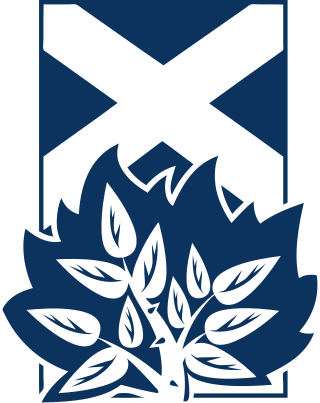
The Church of Scotland is a Presbyterian denomination of Christianity that holds the status of the national church in Scotland. It is one of the country's largest, having 259,200 members in 2023. While active membership in the church has declined significantly in recent decades, the government Scottish Household Survey found that 20% of the Scottish population, or over one million people, identified the Church of Scotland as their religious identity in 2019. The Church of Scotland's governing system is presbyterian in its approach, therefore, no one individual or group within the church has more or less influence over church matters. There is no one person who acts as the head of faith, as the church believes that role is the "Lord God's". As a proper noun, the Kirk is an informal name for the Church of Scotland used in the media and by the church itself.
John Willock was a Scottish reformer. He appears to have been a friar of the Franciscan House at Ayr. Having joined the party of reform before 1541, he fled for his life to England. There he became noted as a zealous and taking preacher. This led to his arrest for heresy under an Act of Henry VIII., "for abolishing diversity of opinion" in matters of religion. He was found guilty of preaching against purgatory, holy water, priestly confession, and prayer to the saints, and of holding that priests might lawfully be married, he was for some time confined in the Fleet prison. After the accession of Edward VI he was chaplain to Henry, Duke of Suffolk, who had married King Henry's niece, and is best known as the father of Lady Jane Grey. He preached for a time in London, in St Katherine's Church, when both he and John Knox, his fast friend, were granted general license to preach anywhere in England. Henry, Earl of Huntingdon, presented him to the rectory of Loughborough in Leicestershire, a living which he continued to hold during King Edward's reign, and again during that of Queen Elizabeth for the rest of his life. Thus in his later years he was in the unique position of being at the same time a parish minister in both England and Scotland. When Mary Tudor came to the English throne in 1553, Willock fled to Embden, in the Protestant Duchy of Friesland. There he practised as a physician with much success, and rose to some eminence. In 1555, and again in 1556, the Duchess Anne of Friesland sent him to Scotland as her Commissioner on matters of trade. In 1558 he returned home, and preached for some time in Dundee, with much acceptance among the friends of reform. In 1559, when John Knox had to leave Edinburgh in peril of his life, Willook took his place as the evangelist of the Reformation. It was then that he conducted in St Giles what is believed to have been the earliest public celebration of the Holy Communion in Scotland after the reformed ritual. In 1560, when Queen Mary of Guise lay dying, the Earls of Argyll and Moray, and other Lords of the Congregation advised her to "send for a godly, learned man of whom she might receive instruction"; and Willock was chosen to minister to her, which he faithfully did. That same year he was made Superintendent of Glasgow and the West. He was also one of the six Johns entrusted with the drawing up of the First Book of Discipline, the others being John Knox, John Winram, John Spottiswood, John Douglas, and John Row. Sometime in that year he went to England, and brought home his wife, Katherine Picknavell, an English lady. He was chosen Moderator of the General Assembly in 1563, 1564, 1565, and 1568. In 1565 Queen Mary endeavoured to put a stop to his activity by having him imprisoned in Dumbarton Castle; but the Reformers were now too strong for her, and she had to depart from her purpose.

The Scots Confession is a Confession of Faith written in 1560 by six leaders of the Protestant Reformation in Scotland. The text of the Confession was the first subordinate standard for the Protestant church in Scotland. Along with the Book of Discipline and the Book of Common Order, this is considered to be a formational document for the Church of Scotland during the time.
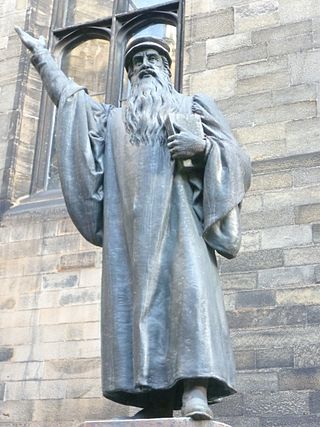
The Scottish Reformation was the process whereby Scotland broke away from the Catholic Church, and established the Protestant Church of Scotland. It forms part of the wider European 16th-century Protestant Reformation.
The Scottish Reformation Parliament was the assembly elected in 1560 that passed legislation leading to the establishment of the Church of Scotland. These included the Confession of Faith Ratification Act 1560; and Papal Jurisdiction Act 1560. The legislation was not formally approved until 1567, when it was ratified by James VI.
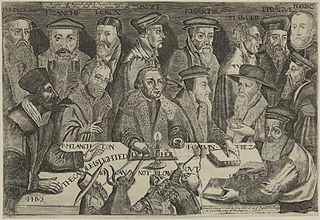
Reformed Christianity originated with the Reformation in Switzerland when Huldrych Zwingli began preaching what would become the first form of the Reformed doctrine in Zürich in 1519.
The history of the Scottish Episcopal Church is traced by the church to ancient times. The Church today is a Christian denomination in Scotland and a member of the Anglican Communion. It has enjoyed a distinct identity and is neither Roman nor English. It is therefore not a Daughter Church in the Anglican communion.

The history of Christianity in Scotland includes all aspects of the Christianity in the region that is now Scotland from its introduction up to the present day. Christianity was first introduced to what is now southern Scotland during the Roman occupation of Britain, and is often said to have been spread by missionaries from Ireland in the fifth century and is much associated with St Ninian, St Kentigern and St Columba, though “they first appear in places where churches had already been established”. The Christianity that developed in Ireland and Scotland differed from that led by Rome, particularly over the method of calculating Easter, and the form of tonsure until the Celtic church accepted Roman practices in the mid-seventh century.

Scotland in the early modern period refers, for the purposes of this article, to Scotland between the death of James IV in 1513 and the end of the Jacobite risings in the mid-eighteenth century. It roughly corresponds to the early modern period in Europe, beginning with the Renaissance and Reformation and ending with the start of the Enlightenment and Industrial Revolution.

Covenanters were members of a 17th-century Scottish religious and political movement, who supported a Presbyterian Church of Scotland and the primacy of its leaders in religious affairs. It originated in disputes with James VI and his son Charles I over church organisation and doctrine, but expanded into political conflict over the limits of Royal authority.

The Restoration was the return of the monarchy to Scotland in 1660 after the period of the Commonwealth, and the subsequent three decades of Scottish history until the Revolution and Convention of Estates of 1689. It was part of a wider Restoration in the British Isles that included the return of the Stuart dynasty to the thrones of England and Ireland in the person of Charles II.

John Craig was a Reformer, and colleague of John Knox. Originally a Dominican, he became a Church of Scotland minister with significant extra responsibilities and played an influential part in the Scottish Reformation.

The Renaissance in Scotland was a cultural, intellectual and artistic movement in Scotland, from the late fifteenth century to the beginning of the seventeenth century. It is associated with the pan-European Renaissance that is usually regarded as beginning in Italy in the late fourteenth century and reaching northern Europe as a Northern Renaissance in the fifteenth century. It involved an attempt to revive the principles of the classical era, including humanism, a spirit of scholarly enquiry, scepticism, and concepts of balance and proportion. Since the twentieth century, the uniqueness and unity of the Renaissance has been challenged by historians, but significant changes in Scotland can be seen to have taken place in education, intellectual life, literature, art, architecture, music, science and politics.
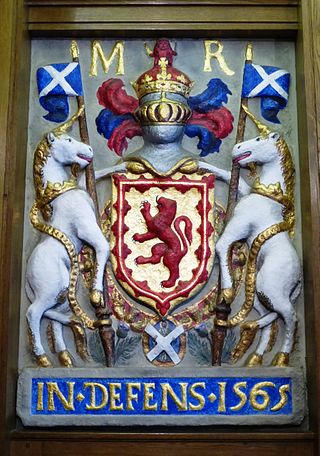
Government in early modern Scotland included all forms of administration, from the crown, through national institutions, to systems of local government and the law, between the early sixteenth century and the mid-eighteenth century. It roughly corresponds to the early modern era in Europe, beginning with the Renaissance and Reformation and ending with the last Jacobite risings and the beginnings of the Industrial Revolution. Monarchs of this period were the Stuarts: James IV, James V, Mary Queen of Scots, James VI, Charles I, Charles II, James VII, William III and Mary II, Anne, and the Hanoverians: George I and George II.

Education in early modern Scotland includes all forms of education within the modern borders of Scotland, between the end of the Middle Ages in the late fifteenth century and the beginnings of the Enlightenment in the mid-eighteenth century. By the sixteenth century such formal educational institutions as grammar schools, petty schools and sewing schools for girls were established in Scotland, while children of the nobility often studied under private tutors. Scotland had three universities, but the curriculum was limited and Scottish scholars had to go abroad to gain second degrees. These contacts were one of the most important ways in which the new ideas of Humanism were brought into Scottish intellectual life. Humanist concern with education and Latin culminated in the Education Act 1496.
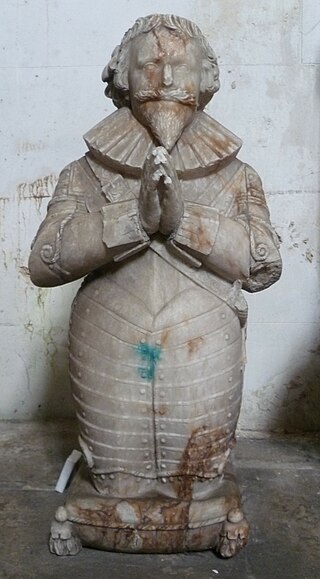
Scottish religion in the seventeenth century includes all forms of religious organisation and belief in the Kingdom of Scotland in the seventeenth century. The 16th century Reformation created a Church of Scotland, popularly known as the kirk, predominantly Calvinist in doctrine and Presbyterian in structure, to which James VI added a layer of bishops in 1584.
John Row (c1525–1580), was a Scottish reformer, born around 1526 near Dunblane. He was educated at the Grammar School of Stirling and St Leonard's College, St Andrews, where he matriculated in 1544. After graduating with an M.A. he studied Canon Law and practised as an advocate in the Consistory Court of St Andrews. In 1550, he was appointed agent for the Scottish clergy at Rome, where he remained seven or eight years. He was awarded Licentiate of Laws, and LL.D. Padua. The fame of his talents and learning led to his intimacy with Pope Paul IV and some of the cardinals, and would probably have led to his promotion ; but owing to ill-health he was compelled to return to Scotland, when he was appointed nuncio to investigate the causes of the Reformation and to devise means for checking its progress. He reached Eyemouth on 29 September 1558, but finding himself unable to fulfil his injunctions, returned to Rome before 11 May 1559. After a short residence there, he came back by persuasion of James, Prior of St Andrews, afterwards Earl of Moray, and having seen the falsehood and imposition of a pretended miracle at St Allaret's Chapel, Musselburgh, he joined the Reformers. He was admitted to Kennoway in April 1560, before the Reformation was fully established. John Row was one of six ministers appointed by the Lords of the Congregation for "writing in a book their judgments touching the Reformation of religion." These appeared in the Confession of Faith and First Book of Discipline. He was translated to Perth 17 July, and admitted before 20 December 1560. He was appointed by the General Assembly, 10 July 1568, to visit Galloway. He was styled Commissioner of Nithsdale and Galloway, March 1570 and elected Moderator of the General Assembly 21 July and 25 December 1567, 24 April 1576, and 11 June 1578. He died on 16 October 1580, at which time he held the vicarages of Twynholm and Terregles in Galloway. He was regarded as "a cautious and prudent reformer, of moderate views, benevolent disposition, and amiable and winning manners, a wise and grave father, of good literature according to the time." He was skilled in the original languages of Scripture, and did much towards building up the Reformed Church in Scotland. He was married in 1560 to Margaret, second daughter of John Beaton of Balfour.
John Spottiswood (1510–1585) was a religious reformer in 16th century Scotland.